Makai-Bhatmas & Kimmerer’s Three Sisters

‘Braiding Sweetgrass’ is a collection of meditative essays revolving around plants. One of those reflective essays, ‘The Three sisters’, starts discussing the relationship between corn, beans, and squash (the three sisters), but then it becomes much more. It beautifully describes their growth, their coexistence, and how they help to create a reciprocal balance together with each other and nature. The writer talks from multiple perspectives. She personalizes the plants, takes reference from folklores, uses elaborate scientific vocabulary, and also reflects from the perspective of a biology teacher struggling to make the subject interesting for her students. Coincidentally, both of us had just finished a lesson on plants in our classes, so this reading felt even more relevant to us. We had recently discussed the parts of plants, their classification, and life processes. We could relate to the idea presented in the chapter very well. This is a compilation of some of the insights we had as we read the chapter and planned a discussion around it.
The first thing that amazed us was the way the chapter was written. By the time we had read the first paragraph, we were amazed by how poetic each sentence read, and how the text had a smooth flow. On diving deeper, we were mesmerized by the way the writer had written science. Science books are generally dense, filled with contextual vocabulary that can make reading very difficult, and often boring. But here we had a scientific text that wasn’t boring. It had all the facts and figures without losing touch with the literature. This text was a practical demonstration of how the ‘A’ of the STEAM, Arts, adds value in things that may be bland otherwise. We realized that this chapter on its own was an example of the integration of STEAM in education. This was the ‘art’ that is often missing from our Science classrooms.
Along with an acute observation of the growth of the plants, the chapter also tells us about an indigenous story passed down through generations about how ‘The Three Sisters’ came to the world. The story inspired us to look for similar stories from our own cultures. We talked to our parents, friends, and colleagues, and also spent some time thinking of similar stories and the kind of knowledge that is passed down for generations in our society. And as we had anticipated, we found some parallels. All across the country, soybeans and maize are planted together, harvested together, and eaten together. They are used in folklore, idioms, and literature as inseparable units, being referred to together as ‘मकै-भटमास’ (muh-kai-bhat-mass) more often than they are referred to individually. People in Nepal have also used medicinal herbs in their traditional ways as cures to ailments very frequently.
But as people who grew up in the capital city, we have been devoid of this kind of traditional knowledge and experiences. Reading the chapter got us reflecting on the need for a similar body of work in our cultural context, that would not just help us bring an immersive learning experience in our classrooms, but also to build an integrated knowledge domain that derives the best of both worlds.
The chapter inspired us in several other ways too. We had a conversation in our school to build a garden space for our students where we could plant crops and flowers for a hands-on learning experience of biology. In an ideal case, we want to get the students involved in the process of planting, harvesting the fruits and the seeds, and again replanting those seeds, so that the students become familiar with the entire life cycle of the plants. We often think of hands-on learning as something involving expensive tools and specifically produced resources but this chapter helped us unlearn the concept. Hands-on learning can just as easily be facilitated with materials available around us, in nature.
We have also decided that we will be using literature like this in our Science classes whenever possible. We are working to build a collection of Nepali stories and poems that could be used to create a more integrated learning experience for our students.
Meeting the three sisters turned out to be a rich learning experience for both of us. It added to our discussions in our classrooms, teachers’ room, and coffee tables. The chapter got us thinking about our practices and gave us some interesting ways to move forward. It made us look out of our classrooms to find an even bigger, more immersive classroom for our students. We highly recommend this book to science teachers to facilitate STEAM-based classes.
Authors’ IntroductionRupesh Bhattarai is a writer and educator based in Kathmandu. Rupesh is interested in fostering critical thinking skills in students using tools of STEAM education and literary arts. Rupesh is also a spoken word poet who has participated and won in several national and international level poetry slams. His works have been published on various Nepali and international media platforms.
Anu Shrestha is an educator cum instructional designer. She has spent the last five years designing STEM-based educational programs and activity-based instructional activities. She has also spent some time travelling to different parts of Nepal conducting programs related to design thinking and STEM education. Currently, she is teaching science to primary students, while pursuing her master’s degree at Kathmandu University School of Education in TVET Education.